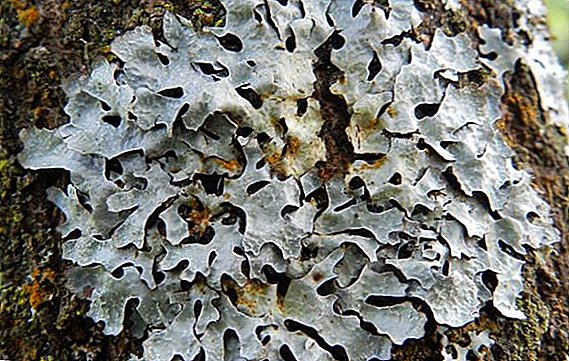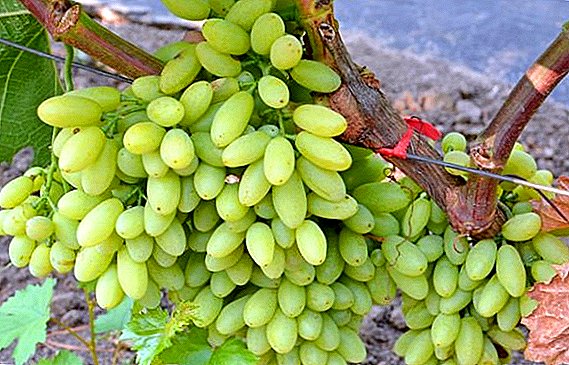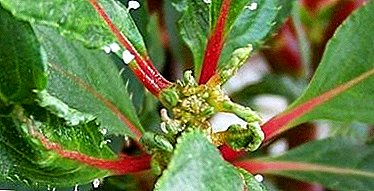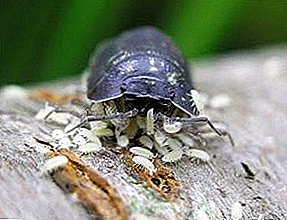 Many summer residents, seeing colorful photos of lilac blossoms, would like to have a few bushes of this attractive plant on the site.
Many summer residents, seeing colorful photos of lilac blossoms, would like to have a few bushes of this attractive plant on the site.
Information on what types of lilacs exist, how and where it grows, when and in what way it is planted, what kind of care it needs, is presented below.
Description and variety
Amateur gardeners often wonder: lilac is a tree or shrub. It has a definite answer - lilac is deciduous shrub with many trunks, which grows from 2 to 8 meters in height with a trunk thickness of up to 20 cm, so many consider it a tree. 
Lilac leaves are covered in early spring and they remain green until late autumn. In appearance, leaves of different varieties have an elongated oval, ovate, heart-shaped form with a sharp top of a light or dark green color.
Read about the beneficial and harmful properties of lilac.When flowering conical panicles are formed, the length of which can reach 20 cm The color of the inflorescences can be white, blue, lilac, purple, purple, pink. The flowers are small four-petal calyx bell-shaped, with a nimbus, two stamens and a flat, divided limb into four parts.

It counts about 30 varieties of lilac, that grow in homesteads, in gardens, parks and just outside.
The most suitable for growing in the country is common lilac, which has been cultivated since 1583 and today is represented by four main varieties with the following description:
- "Red Moscow" - has purple-purple buds and blooming fragrant flowers of a dark purple shade, about 2 centimeters in size;

- "Violetta" - Planted since 1916 as a variety with buds of a dark purple hue and double or semi-double light purple flowers, up to 3 cm in size;

- Primrose - lilac, which has light yellow flowers and greenish-yellow buds;

- "Belisent" - grows in the form of straight and tall bushes with slightly corrugated oval-shaped leaves and strongly smelling coral-pink inflorescences, about 30 cm in size.
If you want cut flowers to be stored longer, find out how to save cut lilacs.If you want to grow something extraordinary in your summer cottage, you should consider options as follows species of lilac:
- Amur - multi-trunk shrub, which is easy to take for a tree, as it grows in nature up to 20 m high, and in culture up to 10 meters. The leaves, in color, in the stage of blooming in spring are colored greenish-purple, and in summer, in a mature state, they are dark green above and light green below. By the fall are purple or yellow-orange. Flowers, smelling honey, white or cream-colored, are collected in large panicles up to 25 cm in size;

- Hungarian - a shrub that grows up to 7 meters, which has dark green shiny leaves with ciliated edges about 12 cm in size. The flowers are small, with a barely perceptible aroma, gathered in panicles with a division into tiers. The species is represented by two garden forms: red (red-purple flowers) and pale (delicate-purple flowers);

- Persian - A hybrid of Afghan and melkonadrezovannoy lilac. It grows up to 3 meters in height and has dense and thin leaves up to 7.5 cm long, green in color. The fragrant flowers of light purple color are collected in broad panicles. In culture, the species is represented by three forms: rassechennolistnaya, white, red;

- Chinese - A hybrid of ordinary and Persian lilac, which was bred in 1777 in France. It grows up to 5 meters in height. It has 10-centimeter leaves and 2-centimeter flowers with a pleasant aroma, which are gathered in panicles up to 10 cm in size pyramidal shape. The best-known forms are: double (purple color of flowers), pale purple, dark purple;

- hyacinth - The result of the crossing of common and broad-leaved lilac, which was conducted by Victor Lemoine in 1899. The leaves of the plant are a dark green heart or egg-shaped with a pointed top. In early autumn, they turn brown with a purple tinge. Flowers are ordinary, but grouped in small inflorescences. Presented by the following forms: "Esther Staley", "Churchill", "Pulp Glory".
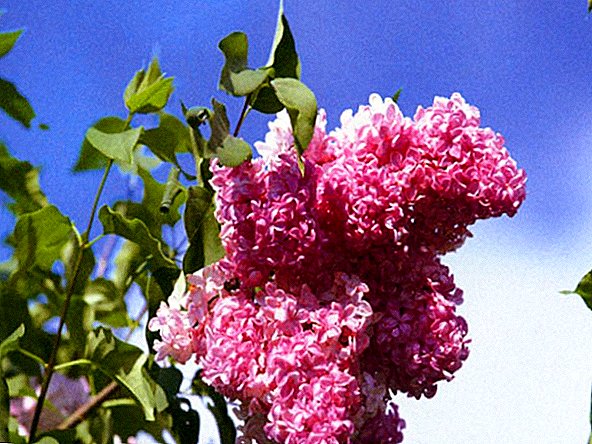
Did you know? There is a sign - if you find a flower with five petals in a lilac brush and eat it, or put it between the pages of a book, you can safely make a wish that will come true.
Growth Conditions
When choosing a place to plant a lilac on your site The following parameters should be considered:
- the intensity and duration of natural light;
- soil type and composition;
- humidity;
- the size of the designated area for growth, development and nutrition of the plant.

Lighting and location
Lilac is an unpretentious plant, and special conditions it is not required. The most suitable place for its landing will be the site located on a plain or a small slope with solar lighting throughout the day. Shrubs planted in the shade will not be lush, their development is slow, and flowering is very weak or absent altogether.
In addition to the lilac, to the family Olive also include such plants: ash, jasmine and privet.
Soil for the bush
All are suitable for lilac cultivated garden soil. Where there are fruit trees, berry bushes, ornamental plants, lilac will feel good.
Don't fit her heavy unstructured and high acidity soils. Acidic soil is neutralized with lime, dolomite flour or ash, but this tool will have to be applied annually. 
Temporarily flooded, marshy or lowland areas are not suitable for lilacs. In such landscapes, it is necessary to create a bulk hill for each bush, rather than a traditional pit, as in a normal planting.
Is problematic and clay soil. But planting is possible under the condition of loosening the seat with the help of sand, neutralized peat, leaf humus or other organic additives. But since the clay does not allow moisture to pass through, it should be ensured that rainwater does not accumulate in such a site in a pit prepared for growth. High humidity areas are detrimental to this plant. 
Important! If groundwater is suitable for a soil surface of less than 1.5 m, such conditions are not suitable for the normal growth of any type of lilac.
Planting lilac
When planting lilacs in open ground and further caring for it, it is important to consider not only the design ideas for decorating your plot, but also the actual needs of the plant itself. 
For normal growth and development of the bush will need free space in the form of a circle with a diameter of at least 4 meters. But as in the summer cottage, as a rule, there is not very much space, it’s permissible minimum distance:
- when planting in groups - 2-2.5 m between the trunks;
- with line landing - 1.5-2 m;
- in the form of a hedge - 1 meter.

Selection of seedlings
Lilac saplings can be purchased in two varieties - own-rooted and grafted.
For novice gardeners, the first option is more appropriate. More often, it is presented in the form of cuttings or root offspring of own-lilac, sometimes - as rooted cuttings.
Varietal grafted seedlings receive from common lilac, Hungarian or privet. The first are considered the best, because they grow and bloom without problems for decades. Others may give an unexpected rejection of a grafted variety in a few years. 
Timing
The most suitable time for the landing of lilac is cut from the second half of August to the end of September. During this period, the plant begins to prepare for the transition to winter dormancy, but for successful rooting, there are still enough warm days left before the onset of winter.
When planting lilacs in late autumn, a month before the first frost should take care of plant protection. To do this, immediately after the planting irrigation, it is necessary to fill the irrigation circle with a loose insulating material, such as dry leaves, sawdust, dried peat. The thickness of the layer must be impressive - 20 cm or more. 
Spring planting should begin as early as possible and always before the appearance of deciduous buds on the branches. In this case, the pit for landing should be prepared in the autumn. Experts do not recommend planting lilac in the spring, as it will take much more effort on successful rooting than when planting in the fall.
Important! In the first summer of the newly planted lilac requires special attention. This applies to timely watering, spraying and protection from the harmful effects of wind and sun.
Pit preparation
Pits for planting seedlings prepared before planting for 2.5-3 weeks. For a two to four-year-old plant, a deepening in the soil with a diameter of 45-50 cm and a depth of 40-45 cm is sufficient. 
The pit is filled with the usual soil, which is added to the humus, rotted manure or dry peat. Up to 20 kg of such organic fertilizers will be required for one pit. For sandy soils, dolomite flour is required, since it contains magnesium, which is usually absent in sandstones. A decrease in soil acidity is achieved by adding 2-2.5 kg of tuff lime.
Together with organic additives the following mineral fertilizers are applied:
- granulated superphosphate - 0.7-0.9 kg;
- potassium sulfate - 150 g;
- phosphate or bone meal - 0.3 kg;
- wood ash - 700-900 g.


Fertilizers are mixed with the main soil in such a way that the main part of them is located in the lower layers of the filled pit.
Scheme and technology
Before planting, the roots should be inspected, and if they are damaged - trim them carefully. Before planting, the entire root system should be treated with a talker — clay based on water mixed with manure.
Before placing the plant in the pit, a conical hill is created in its center, reaching a height of almost to the general level of the surface. When the seedling is placed on it, the roots are evenly spread in all directions in a circle from the base. 
With a natural subsidence of fresh soil bush dives into the soil, so its root neck after planting should go 4-6 cm from the soil.
Having filled up the ground to the desired level, it should be compacted, gently trampling with its feet from the edges to the trunk. Then a circle is formed of the earth in the form of a bulk roller with a height of 15 to 20 cm with the formation of a hole that will hold water during precipitation and watering.
Familiarize yourself with the various breeding methods of lilac.After the plant is planted in the hole, it merges 1.5 to 2 buckets of water. When water is absorbed, the hole is filled with ordinary soil and mulched with a layer of peat from five centimeters thick.
Proper care
Common lilacs require not only proper planting, but also further care, aimed at the dynamic development of the plant. The main actions are timely watering, regular feeding and pruning.
Watering
The first half of the summer watering should be abundant. (up to 30 liters per 1 sq. meter). This is especially true in arid hot weather. In the future, until the fall, watering is required only in the event of a steady drought. Excessive watering at this time leads to the emergence of new shoots that can freeze in winter.
The first year of watering is carried out only in the area of the landing pit. With the increase in the size of the bush, the irrigation zone is expanded. 

Irrigation rates are determined by the location of the bushes. For example, a bush located in a sunny, well-blown place requires a greater volume of water, since intensive evaporation occurs under such conditions.
In spring and summer, the crown is washed with a spray jet of water under pressure from a hose to remove dust and dirt accumulated on the lower levels from the sheets.
Top dressing
To replenish the fertility of the soil on which the bushes grow, additional fertilizing is carried out annually. 
The first feeding is done in early spring, when the first young shoots appear. It includes mineral fertilizers, the number of which is indicated for one bush:
- ammonium nitrate (20-30 g);
- superphosphate (30 g);
- potassium chloride (15-20 g).

The second feeding will be needed in the middle of summer in the form of mineral fertilizers dissolved in 10 liters of water:
- ammonium nitrate (10-15 g);
- superphosphate (40-50 g);
- potassium chloride (25-30 g).


Pruning
If you do not deal with pruning, the height of common lilac can reach significant sizes: from 2 to 4 meters. At the dacha such bushes will take up a lot of space, so every year you should remove young shoots, cut out shoots that grow below the branches of the main crown, weak and dry branches - this is how the crown is formed. The height of the plant is regulated for several years, pruning in the spring before bud break, branches are directed along the growth vertically. Lilac normally tolerates such pruning, constantly releasing new shoots.
Did you know? In England, there is an interesting tradition: if the bridegroom receives a bouquet of lilacs from her when she walks to a girl, this means that he was refused.

Possible diseases and pests
The main problems of lilac are lilac miner moth and bacterial necrosis.
Covering the leaves with brown spots with their further desiccation in the form of rolled tubes indicates that lilac is struck by a mining moth. The following year, sick bushes practically do not bloom. This threat comes with the arrival of summer, when butterflies fly out to lay their eggs on the lower sides of the leaves. A week later, caterpillars appear. By the middle of summer, they fall to the ground and begin to pupate in the upper layers of the soil.
A deep, up to 20 centimeters, digging in the spring and autumn, with the obligatory turning of deep earth layers helps to eliminate such a problem. If the damage to the leaves is small, they should be removed and burned. 
Bacterial necrosis appears in early August. In this case, the leaves turn gray, and the shoots become brown in color. This disease can be transmitted by watering, from insects, along with seedlings, with injuries. The causative agent in the offseason is in diseased shoots and dry fallen leaves.
It will be possible to defeat this disease only in case of timely removal of the affected leaves, cutting of diseased shoots with their subsequent burning. Shrubs that are affected by more than 40% need to uproot and burn.










